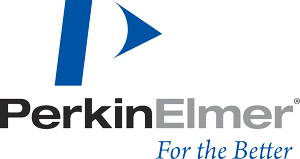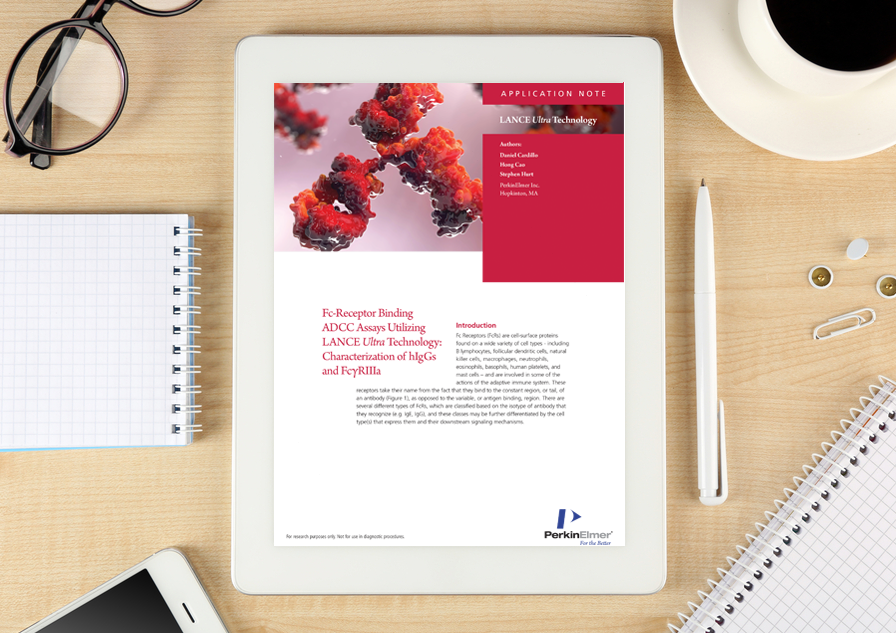Application note: Fc-Receptor binding in ADCC assays utilising LANCE Ultra Technology – characterisation of hIGs and FcγRIIIa
Posted: 4 January 2018 | Daniel Cardillo (PerkinElmer), Hong Cao (PerkinElmer), Stephen Hurt (PerkinElmer) | No comments yet
In this application note, PerkinElmer demonstrates the ease and utility of using LANCE® Ultra, a homogeneous assay format, for determining binding profiles of therapeutic monoclonal antibodies to FcγRs.
Fc Receptors are cell-surface proteins found on a wide variety of cell types and are involved in some of the actions of the adaptive immune system. Specifically, Fc-Gamma Receptors (FcγRs) are members of the immunoglobin superfamily and play a critical role in the function of therapeutic antibodies.
FcγRIIIa is one of two forms of FcγRs and is a low/intermediate affinity receptor for polyvalent immune-complexed IgG. It is involved in phagocytosis, secretion of enzymes and inflammatory mediators, antibody-dependent cellular cytotoxicity (ADCC), mast cell degranulation and clearance of immune complexes. In humans, a single polymorphism creates two isoforms (high and low binding) that when homozygous, may influence susceptibility to immune diseases or response to therapeutic IgG antibodies. As such, FcγRIIIa is considered to be a therapeutic target.
LANCE and LANCE (Lanthanide chelate excite) Ultra are our TR-FRET (time-resolved fluorescence resonance energy transfer), homogeneous (no wash) technologies. One protein of interest is labelled with a donor fluorophore (a LANCE Europium chelate) and the second protein is labelled with an acceptor fluorophore (ULight™ dye). Upon excitation at 320 or 340 nm, energy can be transferred from the donor Europium chelate to the acceptor fluorophore if sufficiently close for FRET (~10 nm). This results in the emission of light at 665 nm
Biomarkers are redefining how precision therapies are discovered, validated and delivered.
This exclusive expert-led report reveals how leading teams are using biomarker science to drive faster insights, cleaner data and more targeted treatments – from discovery to diagnostics.
Inside the report:
- How leading organisations are reshaping strategy with biomarker-led approaches
- Better tools for real-time decision-making – turning complex data into faster insights
- Global standardisation and assay sensitivity – what it takes to scale across networks
Discover how biomarker science is addressing the biggest hurdles in drug discovery, translational research and precision medicine – access your free copy today
Here we use the LANCE Ultra TR-FRET homogeneous technology to take a closer look at the binding of human IgGFc fragment to human FcγRIIIa. We also show that LANCE Ultra can be used to study how other antibodies bind to FcγRIIIa via a competition assay.
This application note is restricted - login or subscribe free to access


Why subscribe? Join our growing community of thousands of industry professionals and gain access to:
- quarterly issues in print and/or digital format
- case studies, whitepapers, webinars and industry-leading content
- breaking news and features
- our extensive online archive of thousands of articles and years of past issues
- ...And it's all free!
Click here to Subscribe today Login here
Related content from this organisation
- Global high-content screening market set to be worth $2.52bn by 2030
- Assays for protein degradation therapeutics to accelerate undruggable proteome discoveries
- Lab automation market set to increase at CAGR of seven percent
- Brochure: Biologics workflow solutions brochure
- Brochure: Viral research solutions
Related topics
Antibodies, Assays, cytotoxicity, Cytotoxicity assays, Drug Discovery Processes, Screening, Therapeutics
Related organisations
PerkinElmer









